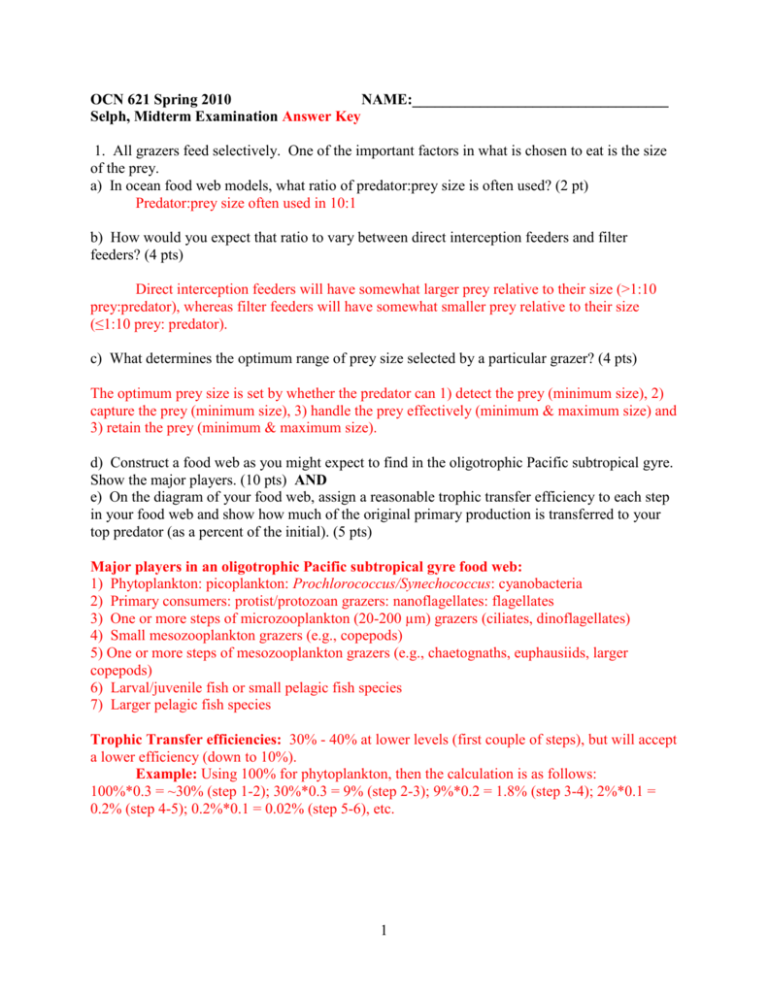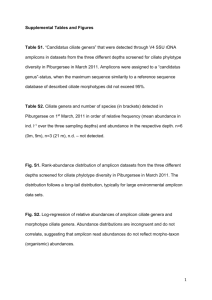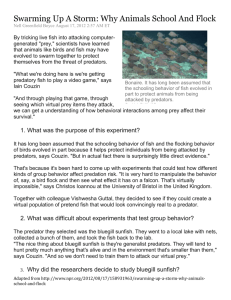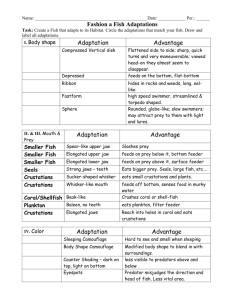Exam Answer Key
advertisement

OCN 621 Spring 2010 NAME:__________________________________ Selph, Midterm Examination Answer Key 1. All grazers feed selectively. One of the important factors in what is chosen to eat is the size of the prey. a) In ocean food web models, what ratio of predator:prey size is often used? (2 pt) Predator:prey size often used in 10:1 b) How would you expect that ratio to vary between direct interception feeders and filter feeders? (4 pts) Direct interception feeders will have somewhat larger prey relative to their size (>1:10 prey:predator), whereas filter feeders will have somewhat smaller prey relative to their size (≤1:10 prey: predator). c) What determines the optimum range of prey size selected by a particular grazer? (4 pts) The optimum prey size is set by whether the predator can 1) detect the prey (minimum size), 2) capture the prey (minimum size), 3) handle the prey effectively (minimum & maximum size) and 3) retain the prey (minimum & maximum size). d) Construct a food web as you might expect to find in the oligotrophic Pacific subtropical gyre. Show the major players. (10 pts) AND e) On the diagram of your food web, assign a reasonable trophic transfer efficiency to each step in your food web and show how much of the original primary production is transferred to your top predator (as a percent of the initial). (5 pts) Major players in an oligotrophic Pacific subtropical gyre food web: 1) Phytoplankton: picoplankton: Prochlorococcus/Synechococcus: cyanobacteria 2) Primary consumers: protist/protozoan grazers: nanoflagellates: flagellates 3) One or more steps of microzooplankton (20-200 µm) grazers (ciliates, dinoflagellates) 4) Small mesozooplankton grazers (e.g., copepods) 5) One or more steps of mesozooplankton grazers (e.g., chaetognaths, euphausiids, larger copepods) 6) Larval/juvenile fish or small pelagic fish species 7) Larger pelagic fish species Trophic Transfer efficiencies: 30% - 40% at lower levels (first couple of steps), but will accept a lower efficiency (down to 10%). Example: Using 100% for phytoplankton, then the calculation is as follows: 100%*0.3 = ~30% (step 1-2); 30%*0.3 = 9% (step 2-3); 9%*0.2 = 1.8% (step 3-4); 2%*0.1 = 0.2% (step 4-5); 0.2%*0.1 = 0.02% (step 5-6), etc. 1 2. Diel vertical migration is a common behavioral trait displayed by many oceanic organisms. a) What is the main environmental cue for diel vertical migration? (2 pts) Light b) What is the accepted ecological reason for why most organisms perform diel vertical migrations? (4 pts) Predation c) Would you expect diel vertical migration to vary between a male copepod and an egg-bearing female copepod? If so, why? (4 pts) Yes, a male copepod is more likely to avoid predation in surface waters during the day by performing a regular diel vertical migration (feeding in the surface waters at night). An eggbearing female copepod is less likely to migrate at all, instead staying in deeper, dark waters, in order to reduce the chances of predation (better hungry than her eggs being eaten). c) Ontogenic vertical migrations also occur in some species. Describe two factors that allow a copepod, such as Neocalanus plumchrus or Calanus Pacificus, spend the entire winter (5 or more months) at depth without feeding. (5 pts) These copepods build up fat stores in the spring/summer surface waters by feeding on phytoplankton/zooplankton. Once they have enough fat stores built up, they then go deep (several hundred meters depending upon the species) and wait out the winter. They slow their metabolism down to their basal metabolic state, which burns less energy (roughly 1/2 of their normal metabolism). The waters at depth are also much colder than in the surface (nearly 10°C colder), further decreasing the energy needed for their resting state metabolism by ~1/2. In addition, because they are burning fat calories, they can get twice the amount of energy from that as burning regular protein/sugars – also allowing them to stay longer without feeding. Finally, the diapause state, where no enzymes are produced, allows even a lower metabolic rate than the basal metabolic rate. If any two of these points was made, full credit was given for this question. 2 3. In a series of experiments where egestion was measured, it was found that a ciliate population grazed on algae with a clearance rate of 100 nl ciliate-1 h-1 when the algae were offered at a concentration of 105 algae ml-1. Other potentially relevant information about this interaction follows: C:N ratio (by weight): Ciliate = 5, Algae = 7 Ciliate’s Assimilation Efficiency: 80% (carbon), 90% (nitrogen) Ciliate’s Net Growth Efficiency (carbon): 40% Carbon content per ciliate: 500 pg carbon Carbon content per algal cell: 5 pg carbon a) Calculate the DAILY ingestion rate of the ciliates (4 pts). Be sure to show units! I = F*C; 100 nl ciliate-1 hr-1 x 105 algae/ml x ml 10-6 nl x 24 h d-1 = 240 algae ciliate-1 d-1. b) Calculate, on a DAILY basis, the amount of prey carbon and nitrogen that went to: 1) growth of the ciliate, 2) the metabolism of the ciliate, and 3) egestion by the ciliate. (12 pts) Carbon budget: Prey carbon ingested daily per ciliate: 240 algae * 5 pg carbon/algae = 1200 pg carbon ciliate-1 d-1 Ciliate’s Net Growth Efficiency = 40%, and Ciliate’s AE for carbon = 80%, and NGE = G/(M+R); 40% = G/(80%), which is 32% for G. So, 1200 pg carbon x 0.32 = 384 pg carbon towards ciliate growth per day. At a AE of 80%, then 1200 pg carbonn x 0.20 = 240 pg carbon towards cilate egestion per day. And finally, 1200 pg carbon – 384 pg carbon – 240 pg carbon = 576 pg carbon towards ciliate metabolism per day. Nitrogen budget: Prey nitrogen ingested daily per ciliate: 1200 pg carbon divided by 7 (C:N of prey) = 171 pg nitrogen ciliate-1 d-1 To maintain ciliate’s stoichiometry, divide 384 pg carbon (growth) by C:N of ciliate at 5 = 76.8 pg nitrogen towards ciliate growth per day Assimilation efficiency for nitrogen is 90%, so 171 pg nitrogen x 0.1 = 17.1 pg nitrogen towards ciliate egestion per day Now, to get metabolism: 171 pg nitrogen – 76.8 pg – 17.1 pg = 77.1 pg nitrogen towards ciliate metabolism per day c) What is the gross growth efficiency of the ciliate in terms of carbon? Nitrogen? (4 pts) GGE (carbon) = 384/1200 = 32% (or already calculated from NGE and AE) GGE (nitrogen) = 76.8/171 = 45% d) If this ciliate-algal grazing interaction were taking place in the surface ocean, what would be the likely fate of the egested carbon and nitrogen? Contrast this with the fate of the egesta if the herbivore was a diel vertically migrating copepod instead of a ciliate. (10 pts) The egested material of the ciliate would likely be remineralized in the upper ocean (recycled) and therefore could become substrate for heterotrophic bacteria in the euphotic zone. A copepod’s egesta would be packaged into a fecal pellet, which would probably sink rapidly out of the surface waters, to be remineralized at depth below the euphotic zone (still by heterotrophic bacteria). If the copepod did not produce its fecal pellets in the surface water, but rather at depth during the day (where it migrated to), then the egesta would probably be remineralized even deeper in the water column. 3 4. Compare the different strategies that freshwater and marine fish display for offspring survival. Include in your answer the main factors that affect fish survival prior to recruitment into an adult stock. (15 pts) Main factors that affect fish surviving long enough to make it to adulthood (recruitment into stock): 1) First feeding to prevent starvation and 2) avoiding predation. Freshwater fish: These fish usually have fewer eggs/larvae than marine fish, but these eggs/larvae are more competent (larger, bigger yolk sak). This strategy is thought to arise from freshwater fish living in a more crowded environment, where we would expect more competition for food resources and potentially higher predation. Thus, the shorter time the eggs/larvae stay vulnerable, the higher the survivorship. Some “parent” fish also stay with their young (brooding or just in the vicinity) to help their early survival by reducing predation risk. Marine fish: These fish usually have many more eggs, and broadcast them into the environment for better distribution in a patchy food environment. In contrast to freshwater environments, each egg or larvae is less well developed and the larvae may also have smaller yolk sacks (trade off between numbers and development time). Since there are many more eggs, a higher percentage can die due to predation or starvation and there will still be enough left to maintain the adult stock levels. 5. The Peruvian anchovetta is the top fished species in the world. What about its life cycle and behavior allows such a great harvest of these fish? Also explain why landings in this fishery may change greatly on a year-to-year basis. (15 pts) Life cycle: Adult in one year (fast to mature), life span 3 years. Feeds directly on phytoplankton or on herbivorous zooplankton, so capable of converting primary production to fish production with very low losses to metabolism/egestion – that is, more of the primary production goes directly to fish production (short food chain). Behavior: Schools in near shore areas – easy to find by fisherman Year-to-year fluctuations in populations: Because these fish are very closely tied to the amount of primary production, when that production varies, so do the fish stocks. El Nino, a recurring phenomena that shuts down upwelling of nutrients to the surface waters where these fish live, affects these stocks dramatically. 4








